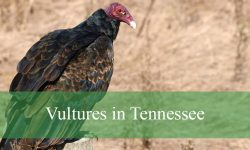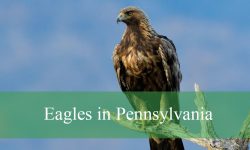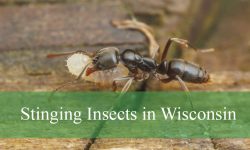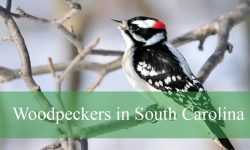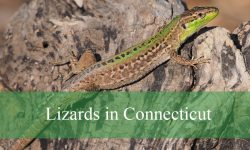New York’s forests, parks, and urban neighborhoods are teeming with squirrels, each with unique colors, behaviors, and habitats. From the common Eastern Gray to elusive flying squirrels, these agile creatures are a fascinating part of the state’s wildlife.
Whether you’re exploring city parks or upstate forests, spotting and identifying squirrels can be a fun and educational experience. This guide highlights 8 squirrel species in New York, complete with photos and identification tips to help you recognize them.
Common Squirrels Found in New York
Eastern Gray Squirrel (Sciurus carolinensis)
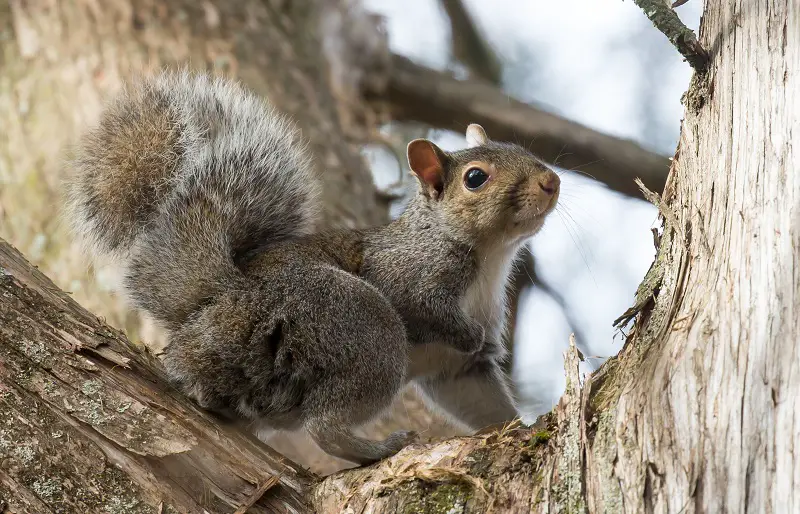
The Eastern Gray Squirrel is easily recognizable by its predominantly gray fur, bushy tail, and occasional brownish highlights. Adult squirrels typically measure 9 to 12 inches in body length, with tails adding an additional 7 to 10 inches. They weigh between 14 to 21 ounces, making them medium-sized among tree squirrels. Their expressive eyes and nimble limbs help them navigate trees and urban landscapes with ease.
Eastern Gray Squirrels are highly adaptable and can be found across New York in urban parks, suburban neighborhoods, and deciduous or mixed forests. They are diurnal, most active during the early morning and late afternoon, often foraging on the ground or leaping between trees. Their diet mainly consists of nuts, seeds, fruits, fungi, and occasionally bird eggs or insects, which they cache for winter months.
Behaviorally, these squirrels are agile, curious, and social, often seen chasing each other or engaging in vocalizations like barks and chatters. They construct leaf nests, called dreys, in tree branches or take over abandoned bird nests. Their territorial behavior is moderate, with overlapping home ranges, especially in urban areas where food is abundant.
Fun fact: Eastern Gray Squirrels are excellent problem solvers and have been observed remembering hundreds of buried nuts. Their population in New York is so dense that they sometimes outcompete other squirrel species, including the less common fox squirrel.
Eastern Fox Squirrel (Sciurus niger)

The Eastern Fox Squirrel is one of the largest tree squirrels in New York, measuring 10 to 15 inches in body length, with tails adding 9 to 12 inches. They usually weigh between 1.5 to 2.5 pounds. Their fur ranges from reddish-brown to rusty tones, with a pale or rusty-colored belly, and a bushy tail that often has a reddish or gray fringe. Their robust build and larger size make them easily distinguishable from the more common gray squirrel.
Fox Squirrels prefer open woodlands, forest edges, and rural farmlands but are less common in highly urbanized areas of New York. They are diurnal and spend much of their time foraging on the ground for nuts, seeds, fruits, and occasionally fungi. They also store food for winter, burying nuts and acorns in shallow soil or leaf litter.
These squirrels are solitary and less social than Eastern Gray Squirrels, often defending larger home ranges. They nest in tree cavities, abandoned bird nests, or leaf dreys. Their loud, raspy calls serve to warn others of predators or assert territory. Despite being less common, they adapt well to areas with scattered trees and open spaces.
Fun fact: Fox Squirrels can leap over 10 feet between trees and are considered one of the most athletic squirrels in North America, which helps them escape predators like hawks and foxes.
American Red Squirrel (Tamiasciurus hudsonicus)
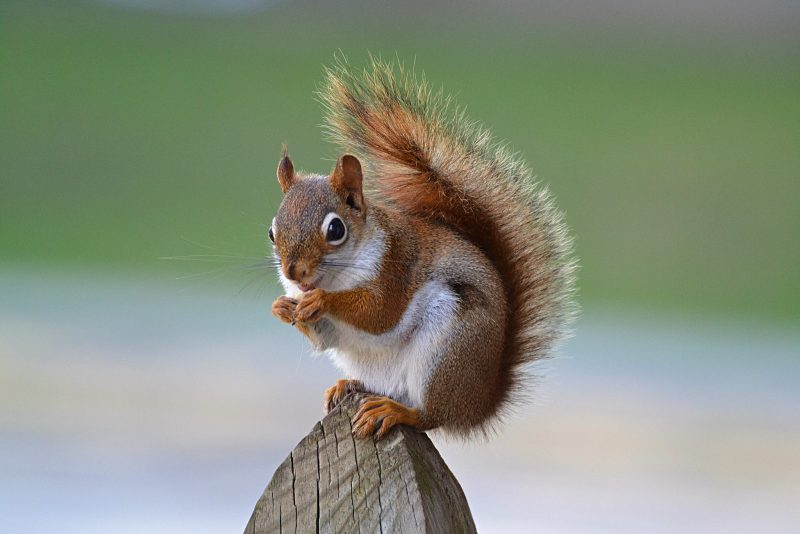
The American Red Squirrel is a small, energetic squirrel, measuring 7 to 9 inches in body length with a tail of 6 to 8 inches. Weighing around 6 to 10 ounces, it is considerably smaller than gray or fox squirrels. Its reddish fur, contrasted with a white or pale belly, makes it distinct, and its sharp, chattering voice is a common sound in New York’s forests.
Red Squirrels are highly territorial, aggressively defending their space, especially around food caches. They are most commonly found in coniferous forests, particularly in northern and upstate New York, where they feed on seeds, nuts, cones, and occasionally bird eggs. Unlike gray squirrels, they store food in small caches and actively guard them from intruders.
Behaviorally, American Red Squirrels are fast, agile, and highly vocal. They construct nests in tree cavities or dense branches, often using bark and leaves. They are also known for their “rattling” alarm calls, which serve as both a warning to others and a threat to potential intruders.
Fun fact: Despite their small size, American Red Squirrels are fearless and can confront much larger animals to protect their food. They are also excellent climbers, able to hang upside down from branches to reach cones and nuts.
Southern Flying Squirrel (Glaucomys volans)
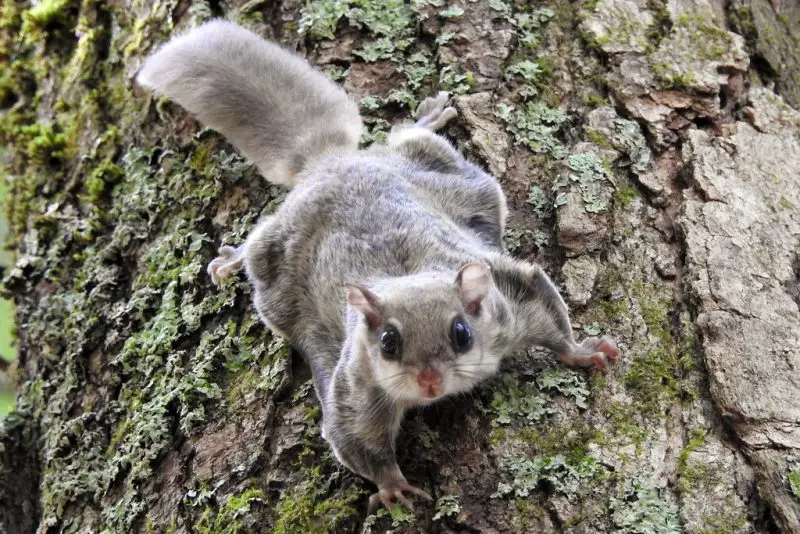
Southern Flying Squirrels are small, nocturnal rodents measuring 8 to 10 inches in total length, including a 3 to 4-inch tail. Their fur is soft and gray-brown on the back with a creamy belly, and they have large, dark eyes adapted for night vision. A distinctive gliding membrane, or patagium, stretches between their wrists and ankles, allowing them to glide efficiently between trees.
These squirrels inhabit mature deciduous forests throughout New York, often in areas with abundant hollow trees for nesting. They are primarily nocturnal and rarely seen during daylight hours. Their diet includes nuts, seeds, fruits, fungi, and occasionally insects, which they often store in tree cavities for later consumption.
Southern Flying Squirrels are social creatures, sometimes nesting in small groups during colder months. They glide from tree to tree using their membrane to escape predators or forage efficiently. Despite their name, they do not truly fly but can glide distances up to 150 feet with remarkable control.
Fun fact: Southern Flying Squirrels have an excellent memory and can relocate hundreds of cached food items. Their nocturnal gliding and small size make them elusive, so many New Yorkers may not realize these tiny aerial acrobats live nearby.
Northern Flying Squirrel (Glaucomys sabrinus)
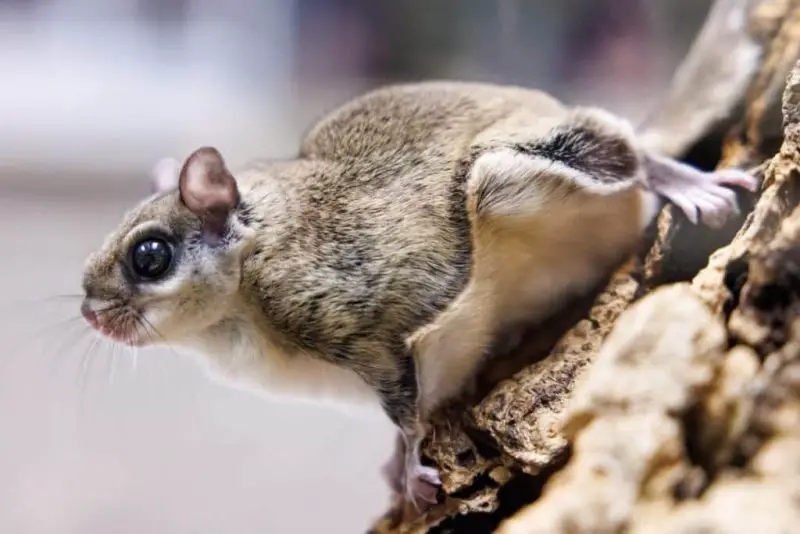
Northern Flying Squirrels are larger than their southern counterparts, measuring 10 to 12 inches in total length with tails of 4 to 5 inches, and weigh 3 to 5 ounces. They have darker gray-brown fur with a pale belly, large black eyes, and a patagium for gliding. Their appearance makes them well-camouflaged in the shadowy canopy of northern forests.
These squirrels are primarily found in the northern parts of New York, inhabiting mixed and coniferous forests rich in mature trees. They are strictly nocturnal, rarely emerging during the day, and feed on fungi, nuts, seeds, lichens, and tree sap. Like southern flying squirrels, they often store food in tree cavities or under bark.
Behaviorally, Northern Flying Squirrels are social and may nest in groups, especially in winter. They are agile gliders, capable of precise aerial maneuvers to avoid predators like owls and weasels. Their home ranges are generally larger than those of southern flying squirrels, reflecting their need for abundant food sources in northern forests.
Fun fact: Northern Flying Squirrels are essential for forest health because they disperse fungal spores, which help trees absorb nutrients. Despite their small size, they play a big ecological role in New York’s forests.
Fox Squirrel Subspecies
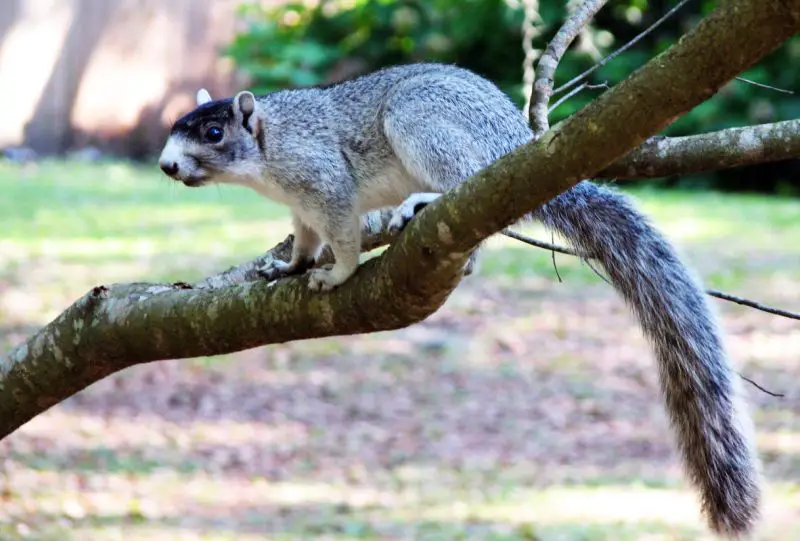
Fox Squirrel subspecies in New York display subtle differences in size, fur coloration, and tail bushiness, reflecting adaptations to their local habitats. While the standard Eastern Fox Squirrel has reddish-brown fur and a pale belly, some northern or upland populations may appear slightly darker or have more grayish tones mixed with red. These squirrels generally range from 10 to 15 inches in body length with bushy tails adding another 9 to 12 inches.
In New York, these subspecies inhabit open woodlands, forest edges, and rural areas, favoring scattered large trees with plenty of ground space for foraging. Their diet is similar to the main species, consisting of nuts, seeds, fruits, and fungi. They are also adept at storing food for winter months, burying acorns and other seeds in shallow soil or leaf litter.
Behaviorally, Fox Squirrel subspecies are mostly solitary and territorial, often defending larger home ranges than gray squirrels. They build nests in tree cavities or leaf dreys and communicate using raspy calls to warn off predators or intruders. Some populations show slight behavioral differences, such as greater ground foraging tendencies or more cautious movements in urban-adjacent areas.
Fun fact: Local subspecies of Fox Squirrels can hybridize with other subspecies in overlapping ranges, creating unique fur patterns and color blends that make them a fascinating study for wildlife enthusiasts in New York.
Hybrid or Color Morphs of Eastern Gray Squirrels
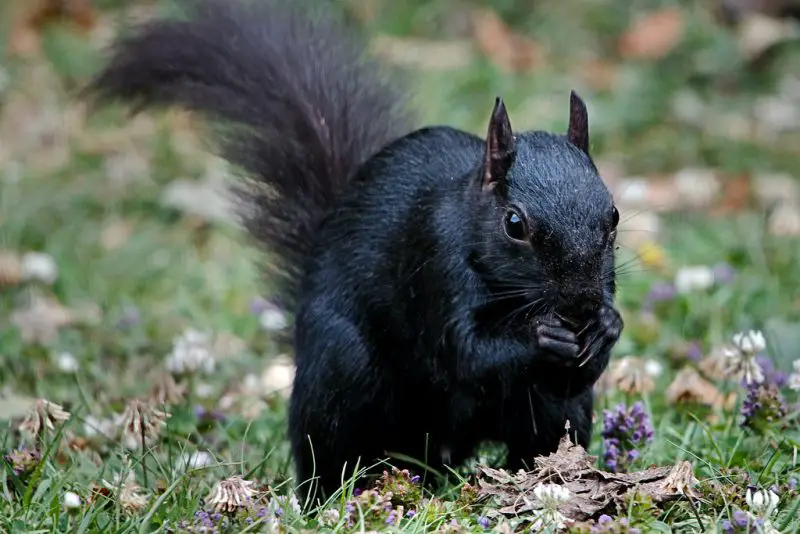
In urban and suburban New York, you may encounter melanistic (all-black) or albino Eastern Gray Squirrels. These are not separate species but color morphs resulting from genetic variation. Melanistic squirrels have dense black fur, while albinos have pure white fur with pink eyes. Their size, behavior, and diet are identical to standard gray squirrels, ranging from 9 to 12 inches in body length with tails of 7 to 10 inches.
These color morphs are most commonly seen in city parks, backyards, and wooded suburban areas. They forage for the same foods as other gray squirrels, including nuts, seeds, fruits, fungi, and occasional bird eggs or insects. Their ability to cache food for winter remains unchanged, and they often compete with standard gray squirrels for resources.
Behaviorally, melanistic and albino squirrels act like typical Eastern Gray Squirrels, with agility in trees, vocal communication, and social interactions. However, the unusual coloration can make them more noticeable to humans—and sometimes predators. Urban environments can offer extra protection due to lower predation pressure.
Fun fact: Melanistic gray squirrels are thought to have a survival advantage in colder northern climates, like upstate New York, because their dark fur absorbs more heat from sunlight. Albino squirrels, while striking, are much rarer due to increased vulnerability in the wild.
Ground Squirrels

True ground squirrels, members of the genus Spermophilus or related genera, are generally uncommon in New York. These species are primarily found in western U.S. states, preferring open prairies and grasslands. However, small, isolated populations or accidental sightings have occasionally been reported in western parts of New York. They are medium-sized rodents, usually 8 to 12 inches long, with short tails and a stockier build compared to tree squirrels.
Ground squirrels are primarily diurnal and live in burrows, creating intricate underground tunnels for nesting, food storage, and protection from predators. Their diet consists of seeds, grains, nuts, and sometimes insects. They exhibit social behavior, often forming colonies with structured hierarchies, unlike the more solitary fox or red squirrels of New York forests.
Behaviorally, ground squirrels are excellent diggers and can hibernate during winter months in colder regions. Unlike tree squirrels, they spend most of their time on or under the ground rather than climbing trees. While they are rarely encountered in New York, when present they tend to favor open fields, meadows, or park edges where burrowing is possible.
Fun fact: Despite their rarity in New York, ground squirrels play an important ecological role in other regions by aerating soil, dispersing seeds, and providing prey for hawks, foxes, and other predators. Their burrows also create habitats for insects and small amphibians.
Frequently Asked Questions About Squirrels in New York
What types of squirrels are found in New York?
New York is home to several tree and flying squirrel species, including the Eastern Gray Squirrel, Eastern Fox Squirrel, American Red Squirrel, Southern Flying Squirrel, and Northern Flying Squirrel. There are also occasional color morphs of gray squirrels and rare sightings of ground squirrels.
How can I identify an Eastern Gray Squirrel?
Eastern Gray Squirrels are medium-sized, with gray fur, occasional brown tones, and a bushy tail. They are highly adaptable and found in urban parks, suburban areas, and forests throughout New York.
What is the difference between an Eastern Fox Squirrel and a Gray Squirrel?
Eastern Fox Squirrels are larger, with reddish-brown fur and a rusty-colored belly, while Gray Squirrels are smaller with gray fur. Fox Squirrels are less common in New York and prefer open woodlands and rural areas.
Where do American Red Squirrels live?
American Red Squirrels are mostly found in coniferous forests, especially in northern and upstate New York. They are highly territorial and often defend their food caches aggressively.
Are flying squirrels common in New York?
Flying squirrels are nocturnal and harder to spot. Southern Flying Squirrels live in mature deciduous forests, while Northern Flying Squirrels prefer northern mixed and coniferous forests. Both glide between trees using their patagium.
What are some unique color variations of Eastern Gray Squirrels?
In urban areas, you might see melanistic (all-black) or albino gray squirrels. These are not separate species but genetic color morphs. Melanistic squirrels absorb more heat, while albinos are rare due to higher predation.
Do ground squirrels live in New York?
True ground squirrels are very rare in New York, mostly found in western states. However, a few isolated reports exist of small populations in open fields or park edges.
What do squirrels eat in New York?
Squirrels primarily eat nuts, seeds, fruits, fungi, and occasionally insects or bird eggs. They often store food in caches for the winter. Flying squirrels may also consume tree sap and lichens.
Are squirrels harmful to humans or property?
Generally, squirrels are harmless, though they may chew on wires, attic insulation, or garden plants if food sources are limited. They play an important ecological role in seed dispersal and forest health.
Fun facts about squirrels in New York
Eastern Gray Squirrels can remember hundreds of buried nuts. American Red Squirrels are surprisingly fearless and defend their territory vigorously. Flying squirrels help disperse fungal spores, supporting tree growth in forests.

